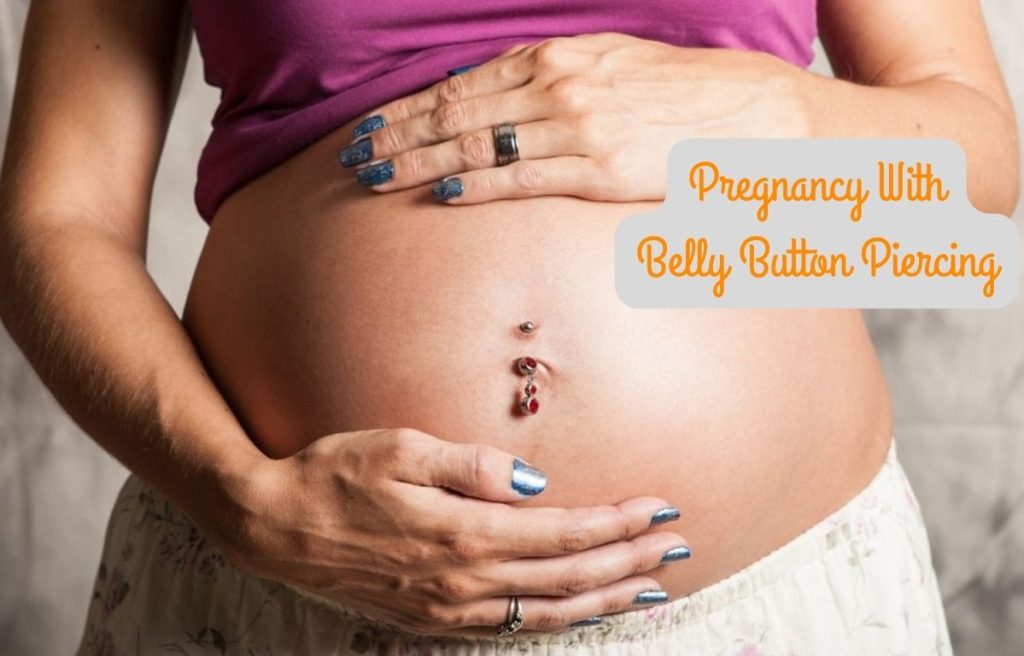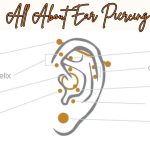Being pregnant with a belly button piercing is generally safe, but there are a few things to consider. As your belly grows, the skin around the piercing might stretch, and this can sometimes be uncomfortable or cause irritation. Some women choose to remove their belly button rings during pregnancy to avoid these issues.
If you decide to keep your piercing, you can switch to a flexible bar made of materials like PTFE or Bioplast, which can bend and adjust as your body changes. These are often called “pregnancy belly rings.” Keeping the area clean is crucial to prevent infections. Make sure to clean your piercing gently with mild soap and water.
If you notice any signs of infection, like redness, swelling, or discharge, it’s important to see your doctor. Also, if the piercing becomes too painful or the skin looks like it might tear, removing the jewelry might be the best option.
Most importantly, listen to your body and do what feels right for you. Every pregnancy is different, and what works for one person might not work for another. Always consult with your healthcare provider if you have any concerns.
How to Care for a Belly Button Piercing During Pregnancy
Almost all of us know that what is a belly button piercing, but most of us don’t know how to care for it. Well, caring for your belly button piercing during pregnancy involves a few extra steps to ensure it stays clean, comfortable, and free from infection as your body changes. Here are some key tips:
1. Switch to Flexible Jewelry:
Use a flexible, non-metallic barbell made from materials like PTFE or Bioplast. These pregnancy belly rings can bend and adjust as your belly grows, reducing the risk of irritation and tearing.
2. Keep It Clean
Gently wash the piercing area with mild, fragrance-free soap and warm water daily. Avoid using harsh chemicals or alcohol-based products, which can dry out and irritate the skin.
Pat the area dry with a clean towel or let it air dry.
3. Monitor for Signs of Infection:
Watch for redness, swelling, unusual discharge, or increased pain around the piercing. If you notice any of these signs, contact your healthcare provider promptly.
4. Avoid Tight Clothing:
Wear loose, comfortable clothing to prevent pressure and friction on the piercing. Tight clothes can irritate the area and increase the risk of infection.
5. Don’t Touch It Unnecessarily:
Avoid touching or twisting the jewelry unless you are cleaning it. Touching the piercing with unwashed hands can introduce bacteria and cause infection.
6. Use Hypoallergenic Products:
If you need to apply any creams or lotions near the piercing, ensure they are hypoallergenic and free from harsh chemicals that could irritate the skin.
7. Be Mindful of Activities:
Be cautious during activities that could put pressure on your belly or risk snagging the jewelry, such as certain exercises or sports.
8. Stay Hydrated and Maintain Good Nutrition:
Keeping your skin healthy and elastic can help accommodate the changes in your body. Drink plenty of water and eat a balanced diet rich in vitamins and minerals.
9. Consult Your Healthcare Provider:
Regularly check in with your healthcare provider about the status of your piercing, especially if you experience any issues or have concerns.
10. Consider Removal if Necessary:
If the piercing becomes too uncomfortable or shows signs of serious irritation or infection, it might be best to remove the jewelry temporarily. You can re-pierce the area after pregnancy if needed.
By following these steps, you can help ensure your belly button piercing remains healthy and comfortable throughout your pregnancy.
Can I Keep My Belly Button Piercing During Pregnancy
Yes, you can keep your belly button piercing during pregnancy, but it requires careful management. As your belly grows, the skin around the piercing will stretch, which can cause discomfort or irritation. To accommodate these changes, consider switching to a flexible barbell made of PTFE or Bioplast, designed to bend and adjust with your body.
Maintaining good hygiene is crucial. Clean the area daily with mild, fragrance-free soap and warm water, avoiding harsh chemicals or alcohol-based products that can irritate the skin. Be vigilant for signs of infection, such as redness, swelling, or unusual discharge, and consult your healthcare provider if these occur.
Wear loose, comfortable clothing to avoid pressure and friction on the piercing. Tight clothing can increase the risk of irritation and infection. If the piercing becomes too uncomfortable or shows significant irritation, removing the jewelry temporarily may be necessary to allow the area to heal.
Always consult your healthcare provider about keeping your piercing during pregnancy. They can provide personalized advice and address any concerns. By following these guidelines and maintaining regular check-ups, you can manage your belly button piercing safely throughout your pregnancy.
What Kind Of Jewelry Should I Wear If I Keep My Piercing
Will My Belly Button Piercing Stretch Or Tear
Yes, your belly button piercing can stretch or potentially tear during pregnancy. As your belly expands, the skin around the piercing will stretch to accommodate your growing abdomen. Here are some key points to consider:
1. Stretching
- Normal Stretching: It’s common for the skin around the piercing to stretch as your belly grows. This is generally a gradual process and can be managed with flexible jewelry that adjusts to your body changes.
- Stretch Marks: The stretching of your skin might lead to stretch marks around the piercing. This is a natural part of the skin’s adaptation to pregnancy.
2. Risk of Tearing
- Increased Risk: The risk of tearing increases if the skin becomes overly stretched or if the jewelry is too tight. Tearing can be uncomfortable and may require medical attention to prevent infection.
- Comfortable Jewelry: To minimize the risk, use flexible, non-metallic jewelry designed for pregnancy. These materials are more adaptable and reduce the strain on the piercing.
3. Monitoring and Care
- Regular Checks: Regularly monitor your piercing for any signs of discomfort, irritation, or excessive stretching. If you notice the skin becoming very thin or tight, it’s crucial to address the issue promptly.
- Consult Your Healthcare Provider: If you experience significant discomfort, signs of tearing, or other concerns, consult your healthcare provider. They can offer guidance and help manage any complications that may arise.
By choosing the right jewelry and monitoring your piercing carefully, you can reduce the risk of stretching or tearing and maintain comfort throughout your pregnancy.
How Do I Care For My Piercing During Pregnancy
Caring for your belly button piercing during pregnancy requires extra attention to ensure it remains clean, comfortable, and free from complications. Here’s a concise guide to help you manage your piercing effectively:
1. Switch to Flexible Jewelry
- Use Flexible Materials: Opt for a flexible barbell made from materials like PTFE or Bioplast. These can bend and adjust with your growing belly, reducing irritation and the risk of tearing.
- Comfort: Flexible jewelry is less likely to cause discomfort compared to rigid metal jewelry.
2. Maintain Good Hygiene
- Cleaning Routine: Clean the piercing daily with mild, fragrance-free soap and warm water. Avoid harsh chemicals or alcohol-based products, which can irritate the skin.
- Drying: Pat the area dry with a clean towel or let it air dry. Avoid using a rough or dirty towel.
3. Monitor for Infection
- Signs to Watch: Look out for redness, swelling, unusual discharge, or increased pain around the piercing. These could indicate an infection.
- Seek Medical Advice: If you notice any signs of infection, consult your healthcare provider immediately for appropriate treatment.
4. Wear Loose Clothing
- Comfortable Fit: Choose loose, breathable clothing to avoid pressure and friction on the piercing. Tight clothing can exacerbate irritation and increase the risk of infection.
- Avoid Friction: Make sure your clothing doesn’t rub against or catch on the jewelry.
5. Avoid Excessive Touching
- Minimize Handling: Refrain from touching or twisting the jewelry unnecessarily. Always wash your hands thoroughly before handling your piercing.
- Prevent Contamination: Reducing contact helps prevent the introduction of bacteria.
6. Use Hypoallergenic Products
- Safe Products: If you need to apply creams or lotions near the piercing, ensure they are hypoallergenic and free from harsh chemicals that might irritate the skin.
7. Adjust Your Activities
- Protect the Piercing: Avoid activities that put excessive pressure on your abdomen or risk snagging the jewelry, such as certain exercises or sports.
- Comfortable Movement: Opt for activities that do not stress the piercing area.
8. Consult Your Healthcare Provider
- Regular Check-ups: Discuss your piercing with your healthcare provider during your prenatal visits. They can offer personalized advice and help address any issues related to your piercing.
9. Consider Removal if Necessary
- Temporary Removal: If the piercing becomes too uncomfortable or shows significant irritation, removing the jewelry temporarily may be beneficial. You can reinsert it after pregnancy if desired.
By following these guidelines, you can manage your belly button piercing effectively and ensure it remains safe and comfortable throughout your pregnancy.
What Should I Do If My Piercing Gets Infected
It is generally not recommended to get a new belly button piercing while pregnant. Here’s why:
- Healing Complications: Pregnancy changes your body significantly, which can affect how well new piercings heal. The stretching of your skin and changes in blood flow can lead to complications, such as increased risk of infection or improper healing.
- Increased Sensitivity: During pregnancy, your skin is more sensitive and prone to irritation. A new piercing might cause additional discomfort and complications, making it harder to manage.
- Risk of Infection: The risk of infection is higher during pregnancy due to changes in your immune system and skin condition. An infection in a new piercing can pose risks for both you and your baby.
- Hospital Policies: Some hospitals have policies regarding body piercings during delivery, and having a new piercing could lead to issues if it gets caught or irritated during labor.
- Advice from Healthcare Providers: Most healthcare providers advise waiting until after childbirth to get a new piercing to ensure both your health and the safety of your baby.
What If The Piercing Becomes Painful
Will The Piercing Go Back To Normal After Pregnancy
To determine if your belly button piercing is stretching too much during pregnancy, look for the following signs:
- Discomfort or Pain: Increased discomfort or pain around the piercing area can indicate excessive stretching. If the discomfort is persistent or worsening, it might be a sign of overstretching.
- Skin Tightness: If the skin around the piercing feels unusually tight or shows visible signs of tension, this could mean the piercing is stretching too much.
- Redness or Irritation: Noticeable redness, irritation, or inflammation around the piercing can suggest that the skin is under too much strain.
- Visible Stretch Marks: Developing stretch marks around the piercing is a sign that the skin is stretching beyond its normal capacity.
- Change in Piercing Shape: If the shape or alignment of the piercing changes, such as the hole becoming oval or elongated, it may be stretching excessively.
- Discomfort with Jewelry: If the jewelry feels too tight or if you experience increased discomfort while wearing it, it might be contributing to the stretching issue.
If you observe any of these signs, it’s important to consult your healthcare provider. They can assess the situation and recommend adjustments or solutions to manage the stretching effectively.
What Should I Do If The Piercing Starts To Itch
If your belly button piercing starts to itch, follow these steps to address the issue:
- Avoid Scratching: Do not scratch or rub the area, as this can worsen irritation and increase the risk of infection.
- Clean Gently: Wash the area with mild, fragrance-free soap and warm water. Use a clean, soft towel to gently pat the area dry. Avoid using harsh or alcohol-based cleansers.
- Apply a Warm Compress: Use a warm, clean compress on the area to help soothe itching and reduce inflammation. Ensure the compress is not too hot.
- Check for Irritants: Make sure that the jewelry is made from a safe, non-irritating material like PTFE or Bioplast. Metal jewelry can sometimes cause allergic reactions or irritation.
- Use Hypoallergenic Products: If you use any products near the piercing, ensure they are hypoallergenic and free from potential irritants.
- Monitor for Infection: Watch for additional symptoms such as redness, swelling, or unusual discharge, which may indicate an infection. If these symptoms develop, seek medical advice.
Can My Belly Button Piercing Cause Complications During Ultrasounds
In most cases, a belly button piercing does not cause complications during ultrasounds. However, there are a few considerations to keep in mind:
Placement and Interference: While the piercing itself typically doesn’t interfere with the ultrasound, it might be necessary to move or adjust it slightly to get a clear image, especially if it’s in the area where the ultrasound probe needs to be placed.
Comfort and Positioning: The presence of a piercing might cause some discomfort if the ultrasound probe presses against it. Inform the ultrasound technician about your piercing so they can take extra care to avoid any discomfort.
Cleanliness: Ensure that the area around the piercing is clean before the ultrasound. Some gel used during the procedure might come into contact with the jewelry, but it’s usually not a concern as long as you clean the area afterward.
Is It Safe To Use Antiseptic Creams On My Piercing During Pregnancy
Should I Avoid Certain Activities To Protect My Piercing During Pregnancy
Q: How can I tell if my belly button piercing is infected?
A: You can tell if your belly button piercing is infected if you notice redness, swelling, warmth, unusual discharge (yellow or green), or increased pain. Consult a healthcare provider for a proper diagnosis.
A: Using a belly band over your piercing can be safe if it’s not too tight and doesn’t irritate the area. Ensure it’s made from soft, breathable material and consult your healthcare provider for guidance.
A: Yes, stretching of the skin during pregnancy can potentially cause scarring around your belly button piercing. The extent of scarring depends on how much your skin stretches and how well you care for the piercing. To minimize scarring, use flexible, non-metallic jewelry, keep the area clean, and follow your healthcare provider’s advice.
A: Yes, you can apply topical antibiotics if your piercing gets irritated, but choose products that are safe for use during pregnancy. Apply a thin layer of a gentle, pregnancy-safe antibiotic ointment. Avoid overuse and consult your healthcare provider for specific recommendations to ensure proper care and to avoid any adverse effects.
A: You should clean your belly button piercing twice daily during pregnancy. Use a mild, fragrance-free soap and warm water to gently wash the area. Ensure it’s thoroughly dried with a clean, soft towel. Consistent cleaning helps prevent infection and irritation while accommodating the skin changes that occur during pregnancy.
A: Yes, it can be normal for the skin around your belly button piercing to become dry during pregnancy due to hormonal changes and skin stretching. To manage dryness, ensure you clean the area gently and apply a mild, fragrance-free moisturizer around the piercing, avoiding direct application to the piercing hole. If dryness persists or worsens, consult your healthcare provider for additional advice.
A: It’s best to avoid swimming in pools or the ocean with your belly button piercing during pregnancy. Submerging in water can increase the risk of infection and irritation. If swimming is necessary, ensure the piercing is protected with a waterproof cover and consult your healthcare provider for specific advice to minimize risks.
A: If your piercing gets caught on your clothing, gently free it without pulling or tugging. If you notice irritation or damage, clean the area with mild soap and water and apply a soothing antiseptic if recommended by your healthcare provider. To prevent future incidents, wear loose-fitting clothing and consult your provider for further advice on protecting your piercing.
A:You can generally wear a flexible barbell throughout pregnancy as long as it remains comfortable and doesn’t cause irritation. Flexible barbells made from materials like PTFE or Bioplast are designed to accommodate skin changes and stretching. However, regularly monitor the piercing for any signs of discomfort or complications, and consult your healthcare provider for personalized advice on managing your piercing during pregnancy.
A: Yes, hormonal changes during pregnancy can affect your piercing. These changes can lead to increased skin sensitivity, swelling, and potential irritation around the piercing. Additionally, skin stretching can impact the appearance and comfort of your piercing. It’s important to monitor your piercing closely, maintain good hygiene, and use flexible, non-metallic jewelry. Consult your healthcare provider for tailored advice and to address any concerns.
A: Yes, you can use a belly button shield to protect your piercing, especially during pregnancy. A belly button shield, typically made from flexible, non-metallic materials, can help prevent direct pressure or irritation from clothing and reduce the risk of accidental trauma. Ensure the shield is clean and properly fitted to avoid additional irritation. Consult your healthcare provider to ensure it’s suitable for your specific situation.
A: Of course, you should avoid certain types of clothing to protect your belly button piercing. Opt for loose-fitting, breathable fabrics to minimize pressure and friction on the piercing. Avoid tight or restrictive clothing, belts, and high-waisted garments that can irritate or put stress on the area. Choosing comfortable, non-irritating clothing helps prevent complications and keeps your piercing healthy during pregnancy.
A: Rapid weight gain during pregnancy can put additional stress on your belly button piercing, potentially leading to stretching, irritation, or discomfort. The skin around the piercing may become tighter and more sensitive, increasing the risk of complications. To mitigate these effects, consider switching to flexible, non-metallic jewelry and maintain proper hygiene. Monitor the piercing closely and consult your healthcare provider for personalized advice and care recommendations.
A: Yes, belly button piercings can affect stretch marks during pregnancy. As your skin stretches, the area around the piercing can become more prone to developing stretch marks. The piercing may cause additional stress on the skin, potentially leading to more noticeable marks. To minimize this risk, use flexible jewelry and regularly moisturize the area. Consult your healthcare provider for further advice on managing your piercing and skin care during pregnancy.
A: You should consider removing your belly button piercing if you notice signs of persistent infection such as redness, swelling, pain, or pus discharge. Continuous irritation or inflammation, skin tearing, significant stretching, or allergic reactions like rashes or bumps also warrant removal. Additionally, if the piercing appears to be rejecting, with the jewelry moving closer to the surface or the skin thinning, it’s best to remove it. Consult your healthcare provider for proper guidance and care if you experience any of these issues.
A: Yes, you can generally get an ultrasound with your belly button piercing in place. However, it’s important to inform the ultrasound technician about your piercing. They may ask you to remove it temporarily if it interferes with the procedure or if there’s a risk of irritation. If the piercing is flexible and non-metallic, it is less likely to cause any issues. Always follow the technician’s or your healthcare provider’s advice for the best outcome.
A: The likelihood of your piercing hole closing if you remove the jewelry during pregnancy depends on how long you’ve had the piercing. If the piercing is relatively new (less than a year old), it may close quickly. For older piercings, the hole is less likely to close completely but may still partially close or shrink. To maintain the piercing, consider using a flexible retainer and consult your healthcare provider for advice.
A: You can typically reinsert your belly button ring after childbirth once your body has had time to heal and return to its pre-pregnancy state. This usually takes about 6 to 12 weeks, but it can vary based on individual healing and any complications. Consult your healthcare provider to ensure the area is fully healed and it’s safe to reinsert the jewelry.
A: Wearing metal belly button jewelry during pregnancy is generally not recommended due to increased skin sensitivity and risk of irritation. It’s safer to use flexible, non-metallic jewelry made from materials like PTFE or Bioplast, which can better accommodate skin stretching and reduce the risk of complications. Always consult your healthcare provider for personalized advice on jewelry during pregnancy.
A: If your belly button piercing starts to bleed, gently clean the area with mild soap and water to prevent infection. Apply light pressure with a clean, soft cloth to stop the bleeding. Avoid using harsh products or applying excessive force. If bleeding persists or you notice signs of infection, consult your healthcare provider for further evaluation and treatment.




